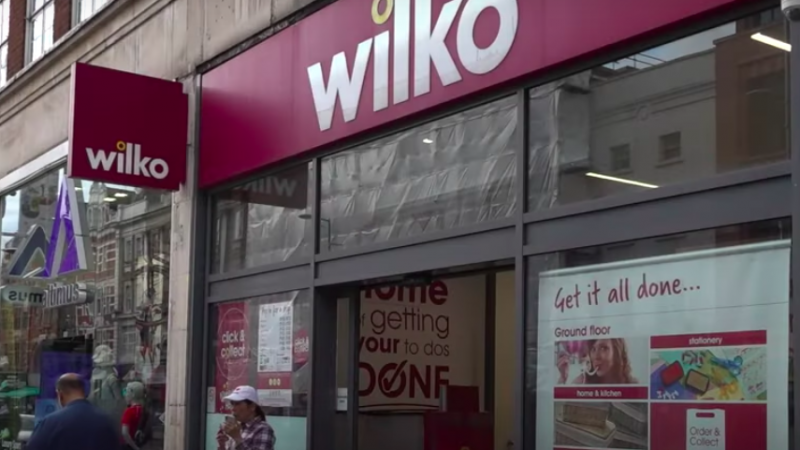Questions ought to be asked about Wilko directors paying £3m in dividends in the financial year to 31 January 2022 when Wilko made a pre-tax loss of £38.7m

The collapse of Wilko has dominated the news headlines. The closure of 400 shops and loss of nearly 12,500 jobs is tragic for already depressed city centres and workers struggling to make ends meet. Some of the shop sites may be bought by other businesses, but sadly Wilko will vanish from high streets.
Corporate Bankruptcies are an inevitable part of capitalism, but the risks are inequitably shared. Workers lose jobs and savings, if they hold shares in the employing company, and also face loss of pension rights.
In general, the pecking order for distribution of proceeds from the sale of bankrupt business’s assets is as follows: liquidators’ fees and expenses, secured creditors with a fixed charge on assets, followed by preferential creditors, floating charge creditors, unsecured creditors and shareholders. In most cases, little is left after paying the liquidator’s fees and secured creditors. Unsecured creditors receive little, if anything.
Amounts owed to pension schemes are treated as unsecured creditors. Unsecured creditors also include a large number of small and fledgling businesses which are often strangled by the collapse of a major client.
In the case of Wilko, the company closed its defined benefit pension scheme in 2013 and it had nearly 2,000 members. The pension scheme is estimated to have a deficit of around £76m on a buyout basis. Some £20m of this is expected to be recovered from crystallisation of the scheme’s security over a number of freehold properties and a distribution centre. That still leaves a £56m hole in the pension scheme.
Questions ought to be asked about Wilko directors paying £3m in dividends in the financial year to 31 January 2022 when Wilko made a pre-tax loss of £38.7m and was haemorrhaging cash as creditors were reluctant to grant credit. In the previous decade, around £77m in dividends was paid out. Directors extracted dividends and chose not to repair the pension scheme. The stark reality for employees is that after years of making full contributions to the pension scheme, they will lose some of their pension rights because as unsecured creditors they will receive little from the sale of Wilko’s assets.
The Pension Protection Fund may bail out insolvent pension schemes but that rescue is restricted to 90% of the promised pension and future promised rises, often linked to inflation, may also be lost or diluted.
A Statement of Affairs filed by the administrators on 31 August 2023 shows that Wilko owed £410m to unsecured creditors, which includes £157m to trade creditors. They are unlikely to recover much and small businesses will suffer, which in turn will destroy the little acorns from which future mighty oaks might grow.
The above pattern has been repeated at BHS, Maplin, Debenhams, Toys R Us, Comet, Thomas Cook, Carillon and many more bankruptcies. The main reason is that the UK bankruptcy laws are inequitable and disproportionately favour banks, private equity and hedge funds, at the expense of workers and small businesses.
The power of finance capital enables providers of loans, mortgages and overdrafts to safeguard their interests by securing charges on assets. In the event of insolvency, they collect most of the proceeds from the sale of assets, leaving little for other creditors. Private equity investors invest little in equity. Most of their investment is in the form of secured loans. Unlike other shareholders this enables them to jump the queue for distribution of assets, and eliminate or drastically reduce the risks arising from bankruptcy.
Neither employees nor SME creditors are in a position to impose charges or covenants upon company assets. Therefore, they end up bearing a disproportionate share of bankruptcy risk.
At the very least, two insolvency law reforms are needed. Firstly, the deficit on the employee pension schemes must be made good before payment to any secured creditor. This is needed because employees are not in a good position to manage the risks arising from employer’s bankruptcy. Their human capital is invested in one employer and cannot be diversified. Human capital can’t be stored and used at a later date. Due to old-age, most workers will not be able to replenish their lost pension pots and face retirement hardships. In contrast, banks, hedge funds and private equity manage their risks by holding diversified portfolios, or as people commonly say, ‘they don’t put all their eggs in one basket’. They have a greater capacity to absorb bankruptcy risks and this ought to be reflected in the way creditors are ranked and assets are distributed.
Secondly, it is grossly unfair that unsecured creditors bear disproportionately high risk of bankruptcy. SMEs predominantly rely upon few customers and are not diversified enough to absorb the loss of vital revenues and cash flows arising from the bankruptcy of a major corporate customer. Their survival would be aided by the receipt of some cash from a bankrupt business. Therefore, around 30%-40% of the amounts available for distribution to creditors, after clearing pension scheme deficits, ought to be reserved for unsecured creditors. This way SMEs will get some cash to aid their survival and possible development.
No doubt, the proposals will be opposed by those benefiting from status quo, but that benefit is derived from hardship on retirees and strangling of SMEs. Such inequities need to be eliminated.
To reach hundreds of thousands of new readers we need to grow our donor base substantially.
That's why in 2024, we are seeking to generate 150 additional regular donors to support Left Foot Forward's work.
We still need another 117 people to donate to hit the target. You can help. Donate today.



